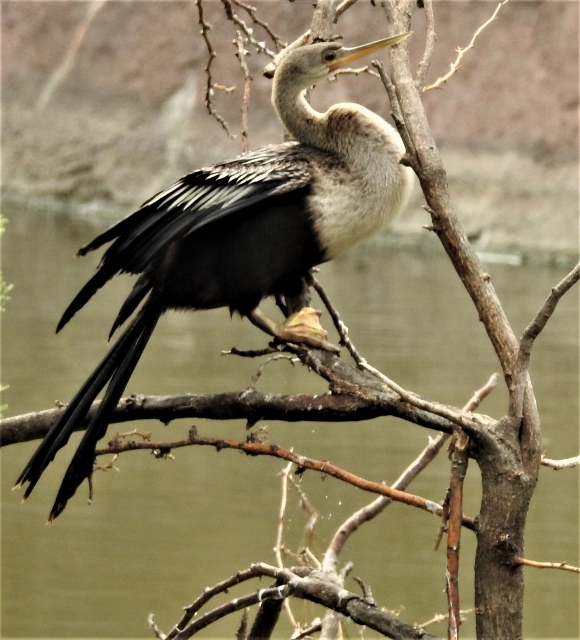by M. Kathy Raines

What a large, peculiar-looking cormorant! I thought, spotting an anhinga on a branch overhanging a resaca at the Gladys Porter Zoo last November. A youth or female, its long, creamy neck formed an ‘S’, with its chest an abrupt buff color above its black posterior, its wings flecked with silver.
The anhinga (Anhinga anhinga), which some endow with spiritual significance, has multiple names. Some call it “snakebird” as, partially submerged, its serpentine neck can be mistaken for a snake. Others call it “water turkey” for its large, fanned tail, “the Grecian lady” for its elegance and even “the Jesus bird” for its resemblance to the crucified Christ when, perching, it spreads its wings to dry and warm itself. Also, it forms a cross shape when it soars high. Cajuns have called it “bec-à-lancette”, meaning “sharp bill”.Also called “peyote bird”, its image, significant in some Native American religions, frequently appears in tattoos and jewelry.
“Anhinga” comes from a Brazilian Tupi word meaning “devil bird”. The bird’s family, Anhingidae, including darters and snakebirds, has four members, only one of which inhabits North America. Anhinga share the order Suliformes with cormorants, frigatebirds and boobies.
Sometimes mistaken for a cormorant, an anhinga has a much larger wingspan, normally about three feet, nine inches. Also, an anhinga has a fanned tail and a longer, more flexible neck which is black in males but buff-colored in females and youth. Male anhinga also wear a black crest. While a cormorant’s bill is hooked, the anhinga’s bill, which is orange and black at the base, forms a straight spear. Finally, the anhinga’s wings are a splendor of silvery markings.
The anhinga is perfectly designed for what it does: swim underwater in pursuit of fish. It has dense, heavy bones, and its plumage can become completely saturated so that buoyancy does not hinder its swimming.
Lacking external nostrils, an anhinga plunges and swims, webbed feet paddling vigorously, to stalk its prey. It may also walk along a stream bed. It stabs its victim—usually a fish, but sometimes a small alligator, frog, turtle or large insect— in the side with a swift thrust of its slightly open beak, a push facilitated by the eighth and ninth vertebrae which form a kind of hinge. Its bill, serrated with inward-pointing barbs, secures the fish. This YouTube video, “Anhinga Stabbing and Eating a Fish”, illustrates its techniques: https://www.youtube.com/watch?v=_cU2h58qewo.
Swimming ashore, sometimes clambering onto a limb, the anhinga manipulates the fish so that, after tossing it in the air, it slides headfirst down its gullet. It occasionally must shake a large fish or bang it against a rock to pry it from its bill.
Between hunts, anhinga perch on branches, wings outspread, backs to the sun, turning wings alternatively to expose tops and bottoms, not so much to dry their wings as to warm themselves. Having poor insulation and low metabolism, their bodies lose heat in cold water. A soaked anhinga, contrary to rumor, can fly; it may burst out of the water to escape, say, a stalking alligator.
Strong, graceful fliers, anhinga, which migrate in large flocks, spiral and soar like hawks, with necks outstretched and fanned tails behind. They flap several times, then glide. The usually quiet anhinga vocalizes with descending sets of clicking, frog-like croaks and grunts: krr kr krrr kr kr krrr krr.
Anhinga thrive in fresh or sometimes brackish water near coasts throughout the Southeast, from North Carolina to Texas, sometimes appearing in the Mississippi Valley northwards into Missouri. They also inhabit Mexico and Central and South America. Migrants to the Valley, they appear occasionally in all seasons except summer.
Javier Gonzalez, Naturalist Educator at South Padre Island Birding, Nature Center and Alligator Sanctuary said they are “very rare on the Island,” but one fall “a very strong front” carried an anhinga there, making it quite “a celebrity bird along the boardwalk that winter.”
Though Texas Parks and Wildlife reports that anhinga breed in the South Texas Brushlands, researchers have not recorded this phenomenon since the 1990s. UTRGV professor Timothy Brush, author of Nesting Birds of a Tropical Frontier, said, “I suspect they do nest in very small numbers, along the river or resacas.”
A male anhinga in breeding plumage grows surplus crest feathers and bears red eyes encircled by blue skin. During courtship, he soars, spiraling over a likely nesting locale. He also flaps his wings, one after the other, and bows deeply. He may lift his tail over his back, bill pointing upwards. This video, “Anhinga Courtship Display”, https://www.youtube.com/watch?v=BiJGC1VHwh0, demonstrates courtship behavior.
The male chooses the nesting site, which he defends, hopping along branches, vocalizing, spreading his wings and opening and shutting his bill. Males gather materials, and couples, interweaving their necks, pass supplies to one another. The female builds the nest, and both incubate and deliver food to chicks. Anhinga often nest in small colonies, along with herons, egrets, spoonbills and other long-legged waders.
Sticks lined with foliage form the sturdy platform, often built on a limb overhanging water. Anhinga may reuse old heron nests. Over the course of a few days, mothers lay from one to five bluish eggs. Chicks hatch in from 25 to 29 days. The altricial, or completely dependent, young are born nearly featherless. Both parents feed the young, who place their skinny heads and necks inside parents’ throats to receive a regurgitated meal.
Chicks, when alarmed, jump into nearby water, scrambling back when a threat is gone, using their webbed feet and bills for traction. They swim before they fly.
Anhinga are now thriving although they, like many birds, suffered before DDT was banned in 1972. They are protected by the Migratory Bird Treaty of 1918—though recently this law has been altered so that industries accidentally killing birds do not face charges.
Anhinga are imperiled by fishing line entanglement, pesticides and other contaminants. In fact, researchers study anhinga to ascertain the effects of contaminated water.

